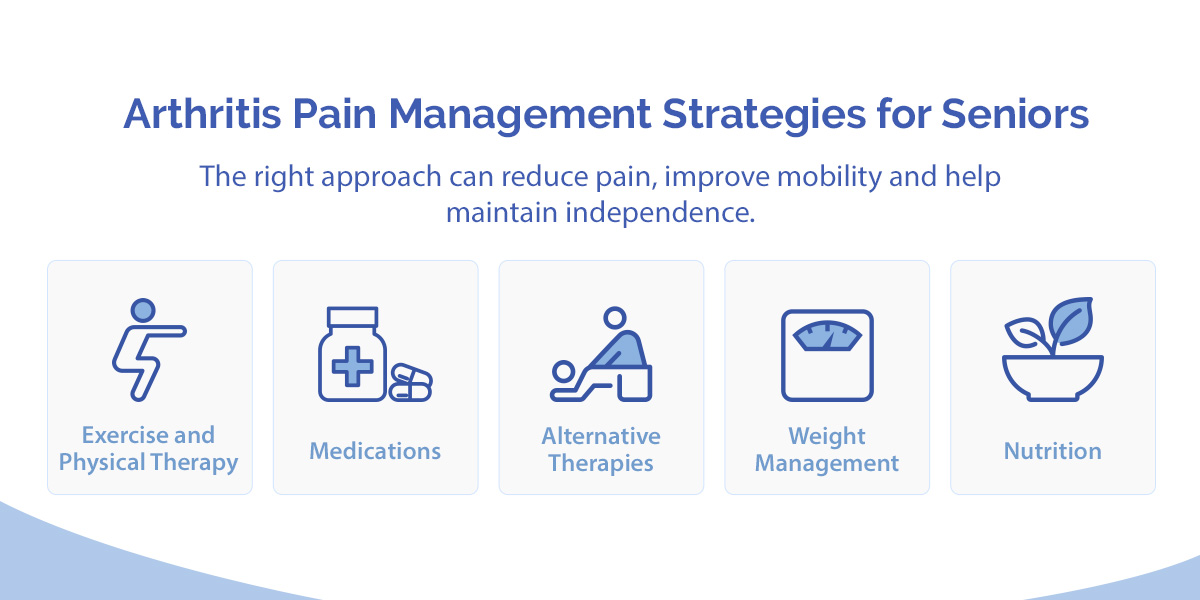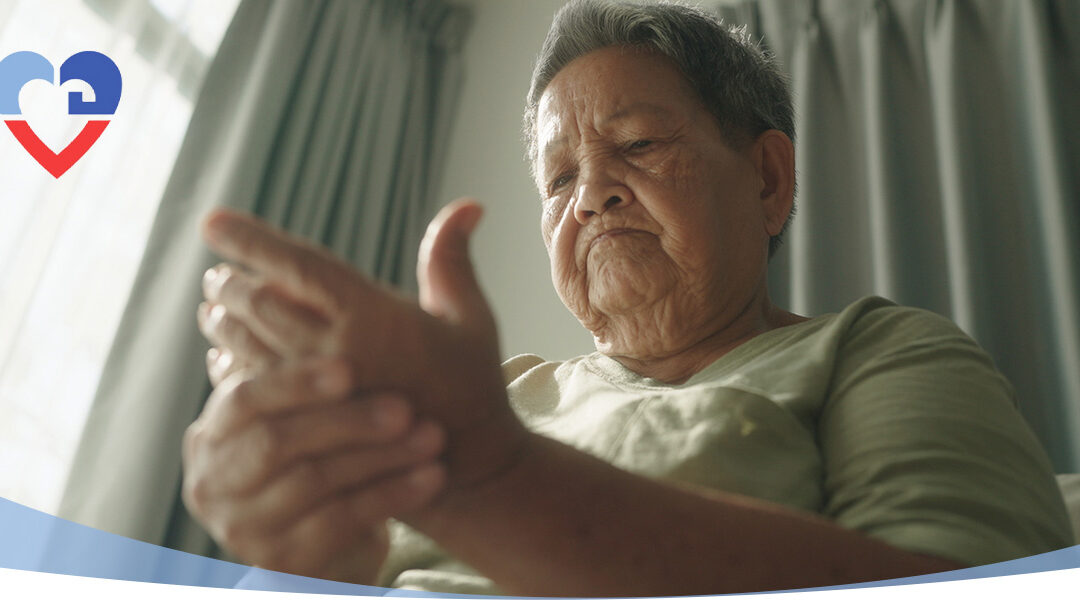Arthritis is one of the most common health challenges facing older adults, affecting millions of seniors across the United States. As we age, our joints naturally experience more wear and tear, causing pain, stiffness and reduced mobility.
Understanding this condition and how it impacts daily life is the first step toward helping seniors with arthritis manage symptoms and maintain independence.
Understanding Arthritis in Seniors
Think of your joints like the hinges on a door. When the door is new, the hinges move smoothly and quietly, and the door opens and closes with ease. Over the years, as the door is pulled and shut thousands of times, the hinges can start to squeak, loosen or even wear down. Without regular care — like oiling or tightening — the hinges may become stiff or creaky, making the door harder to use.
In the same way, our joints are designed to help us move comfortably. But as we age and use them day after day, the protective cushioning can wear down, leading to stiffness, pain and reduced mobility.
These are the facts about arthritis:
- It affects around one in five adults in the U.S. — about 54 million.
- People of all ages can develop arthritis, but arthritis in seniors is most common.
- Over 100 different types of arthritis exist.
- Arthritis affects the joints and other connective tissue of the hands, knees, hips and spine.
- Symptoms can make everyday activities, like walking, dressing or cooking, more difficult.
- Early recognition and proactive management can help seniors stay active and independent.
Common Types of Arthritis Affecting Seniors
Not all arthritis is the same. Seniors are most often affected by osteoarthritis, but other types like rheumatoid arthritis and gout can also cause discomfort. Knowing the differences helps families and caregivers choose the right treatment approach.
Osteoarthritis (OA)
Osteoarthritis is the most common type of arthritis in seniors. It is often called “wear and tear” arthritis. Pain, stiffness, swelling and reduced range of motion occur as joint cartilage breaks down. Contributing factors include:
- Age — the condition presents most often in people over 50.
- Injuries to a joint, like a ligament tear or bone fracture.
- Weak muscles that don’t adequately support the joints.
- Obesity that strains the joints.
- A family history of the condition.
- Misalignment of bone or joint structures.
Rheumatoid Arthritis (RA)
Rheumatoid arthritis in seniors is a systemic autoimmune disease where the immune system attacks the joint linings. Elderly onset RA usually occurs after age 60. Symptoms include:
- Pain, swelling, stiffness and tenderness in several joints.
- Severe stiffness in the morning or after sitting for a long time.
- Stiff and painful joints on both sides of the body.
- Extreme tiredness even after resting.
- Weakness and fever.
Gout
Gout happens when excess uric acid in the blood forms sharp crystals that settle in the joints, causing sudden pain, swelling, warmth and redness. Risk factors include:
- Diet: Eating lots of red meat, shellfish or sugary drinks and drinking alcohol can raise uric acid levels and increase gout risk.
- Weight: Being overweight causes your body to produce more uric acid and makes it harder for your kidneys to remove it.
- Medical conditions: Untreated high blood pressure, diabetes, obesity, metabolic syndrome and heart or kidney disease raise your risk.
- Medications: Low-dose aspirin, some blood pressure medicines and antirejection drugs can increase uric acid.
- Family history: The risk of gout is higher if it runs in your family.
- Age and sex: Gout is more common in men aged 30 to 50 and in women after menopause.
- Recent surgery or trauma: Surgery, injury or even some vaccinations can trigger a gout attack.
Arthritis Pain Management Strategies for Seniors
While there’s no cure for arthritis, many seniors find relief through a combination of lifestyle changes, therapies and medical treatments. The right approach can reduce pain, improve mobility and help maintain independence.

Exercise and Physical Therapy
Low-impact activities like walking, swimming, cycling, tai chi and yoga can help strengthen the muscles around the joints and improve flexibility and balance. Physical therapists can design safe, personalized routines for seniors with arthritis.
Medications
Diagnosis includes a consultation with a health care professional followed by a physical exam. X-rays and imaging can confirm the diagnosis, and blood tests help rule out additional conditions or other causes of symptoms. Once a diagnosis has been made, your doctor can recommend over-the-counter pain relievers or prescription medications for more severe symptoms. Topical creams and gels can provide localized relief.
Alternative Therapies
Heat and cold packs can reduce pain and swelling, while massage therapy can help promote relaxation and circulation. Acupuncture may help some individuals.
Weight Management
Maintaining a healthy weight reduces stress on weight-bearing joints and makes gentle exercise easier. Even modest weight loss can significantly decrease pain.
Nutrition
An anti-inflammatory diet of fruits, vegetables, whole grains, lean or plant-based proteins, and omega-3 fatty acids can reduce inflammation and improve general health. Limit processed foods, sugars and saturated fats wherever possible.
Mobility and Daily Living Tips for Seniors With Arthritis
Arthritis can make daily tasks more challenging, but practical strategies and adaptive tools can help seniors stay safe and independent at home. Small changes can make a big difference in comfort and confidence:
- Assistive devices: Canes, walkers and braces provide support and stability. Jar openers, button hooks and reachers make tasks easier.
- Home modifications: Install grab bars in bathrooms and near stairs. Use raised toilet seats and shower chairs and replace round doorknobs with lever handles.
- Daily living improvements: Avoid sitting for long periods — try to get up and move every hour. Use chairs with arms for easier standing. Break tasks into smaller steps and pace yourself. Wear supportive, nonslip shoes.
- Occupational therapy: Professionals can teach new ways to perform daily activities and recommend adaptive equipment to make life easier.
Emotional Well-Being and Support Resources
Living with chronic pain can take a toll on mental health. Taking care of your emotional well-being is just as important as managing physical symptoms. Support is available for seniors and their families. Support groups like the Arthritis Foundation offer connection and shared experiences, while hospitals and clinics can help you find local arthritis resources near you.
Counseling or therapy can help manage the stress and emotional challenges of living with arthritis. Mind-body practices like meditation, mindfulness and gratitude journaling can also improve mood. It’s important to stay socially active — visiting friends, joining clubs or volunteering can boost well-being.
Family caregivers play a vital role in supporting those dealing with arthritis. In-home care services provide expert assistance, helping seniors maintain independence and families find peace of mind. Compassionate, carefully matched caregivers can help with:
- Personal care like bathing, dressing and grooming.
- Light housekeeping and preparation of nutritious meals.
- Safe mobility and appointment transport.
- Warm companionship and social engagement focused on trust and accountability.
Village Caregiving Is Here for You
Managing arthritis doesn’t have to be overwhelming. With the right support, seniors can continue to live life on their terms. Village Caregiving is here to help you or your loved one stay safe, comfortable and independent at home. Our team works alongside families to bridge the gap between current challenges and desired independence.
We’re committed to compassionate, flexible support. Contact Village Caregiving for a personalized in-home care plan.



Recent Comments